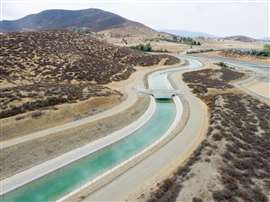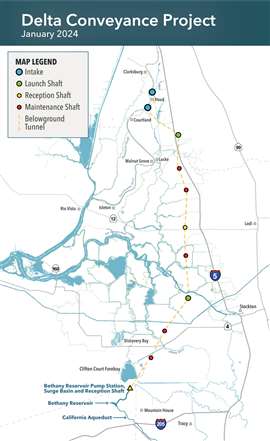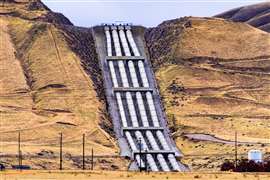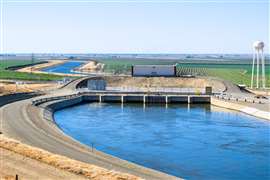Can California’s US$20bn water utility construction curb a climate change catastrophe?
10 September 2024
The Delta Conveyance Project is an immense US$20 billion water utility construction project working through development and permitting in the US State of California. Seeking to reroute the region’s scarce water supply to better serve its population, how will this megaproject deliver on its promise of combating climate change effects with construction?
 An aquaduct system winds through the California landscape. (Image: Adobe Stock)
An aquaduct system winds through the California landscape. (Image: Adobe Stock)
Most of California’s population is quite literally in between a rock and a hard place.
The rock is the Sierra Nevada, the US’ largest mountain range (excluding Alaska), which runs through the state’s central/eastern side and covers about 25% of California’s land area. The hard place is a sea of hard water – salt water, specifically – in the form of the Pacific Ocean along the state’s western coast.
Historically, most of Californians’ drinking water has come from the mountains; a complex series of water utility infrastructure including dams, levees, intakes, and outflows routes melted snowpack through the water system to homes, businesses and farms.
But California officials said climate change has exacerbated the already fragile water conveyance system, and the existing infrastructure has been delivering less water than prior years.
As a result, the California Department of Water Resources (DWR) and its State Water Project (SWP), are planning a colossal conveyance infrastructure project at a value of more than $20 billion.
The scheme, dubbed the Delta Conveyance Project (DCP), will add new and upgrade existing water transmission facilities and install 45 mi- (72km-) worth of concrete tunnels through a regional river delta in between the state capitol of Sacramento and the City of San Francisco. The “Delta” is the confluence of the San Joaquin and Sacramento rivers, the latter of which will receive two new water intakes as part of the project.
Considering the DCP water system will serve just less than an estimated 30 million people (or around 70% of California’s inhabitants) it’s an enormous moment for the US’ largest state by population.
A deeper look at constructing California’s DCP megaproject
 A map of projected works for the California Delta Conveyance Project from January 2024. The design portion of the project is still in development. (Image: DCP Design and Construction Authority)
A map of projected works for the California Delta Conveyance Project from January 2024. The design portion of the project is still in development. (Image: DCP Design and Construction Authority)
Big problems often require big solutions, and the DCP Design and Construction Authority (DCA), which is the joint-powers organisation managing the megaproject, is certainly not shying away from scaling up.
Consisting of representatives from 16 California Public Water Agencies (PWA), the DCA is serviced by the California DWR State Water Project, the statewide public utility agency responsible for water and power infrastructure.
Graham Bradner serves as DCA executive director, and he detailed for Construction Briefing the immense utility build and offered a glimpse at some of the methods and materials that will be used.
“The project would consist of two new intakes along the main stem of the Sacramento River,” he said. “These would be for diverting the State Water Project flows [from] the north Delta [inside a] conveyance tunnel 45-mi long and 36-ft (11m) in internal diameter.”
The project will use tunnel boring machines (TBM) for major tunnelling works.
“That tunnel would connect those intakes in the north Delta down to the existing State Water Project infrastructure in the south Delta,” Bradner explained.
Upgrades would also include construction of a new pumping plant to lift water out of the tunnel and uphill about 250 ft (76m) to the Bethany Reservoir, located about 60 miles (97km) east of San Francisco and just more than 40 miles (64km) straight southwest of the source.
The new Bethany pumping plant would consist of “a series of four parallel 15-ft (4.6m) diameter welded-steel aqueduct pipelines [which] would route their way about 2.5 mi (4km) up the hillside and then discharge into the existing reservoir through a new discharge structure,” said Bradner.
Bradner said concrete will be the single most-used material for the project and noted the use of precast concrete segments and diaphragm walls for subterranean works.
Steel, particularly in the form of rebar and for the aqueduct pipelines, will also be a common element. Bradner said discussions on using steel fibre reinforced materials could also be in play, although he noted those talks would take place at the point of contracting in the coming years.
What’s next for the Delta Conveyance Project?
 A California, US, State Water Project water pumping and aquaduct system at the south end of the San Joaquin Valley. (Image: Adobe Stock)
A California, US, State Water Project water pumping and aquaduct system at the south end of the San Joaquin Valley. (Image: Adobe Stock)
The programme still needs to acquire various permits through 2026, but it received approval from the state DWR following the release of the agency’s Environmental Impact Report for the DCP.
Permits surrounding protections of endangered species would be next, followed by water rights permitting early next year.
For now, development and design continue internally with the hope to implement plans upon the completion of the permitting processes, expected to last several more years.
The organisation has started the process of identifying potential preferred contracting partners for design, but official tenders for preconstruction also may not surface for years.
“We would plan to initiate construction in mid-2029,” said Bradner. “That would be starting with early works elements, so our power infrastructure and connections needed for construction, road access, and any of the logistical-related elements would be constructed in those early phases.”
The largest equipment, the TBMs, would be some of the first pieces acquired, Brander said. Due to the expanse of the boring phases, he suggested the ‘sooner the better’ for getting TBMs on-site.
“We would procure… at least the contractors [providing the TBMs] relatively early so we could start construction of the tunnel shafts and the launch shafts,” Bradner confirmed, expecting boring to start in 2033 or 2034. “So, 2035 is about the peak of construction activities.”
Commissioning could take place as early as 2042, he said, with utility operations commencing in 2045.
Climate change made Delta Conveyance Project mandatory
For Carrie Buckman, the environmental programme manager for California DWR, a new conveyance facility – which serves more than 27 million people and 750,000 farmland-acres from north of Sacramento to south of Los Angeles – was always envisaged, but changes in climate have pushed the project from ‘wish list’ status to ‘ASAP’ level.
“The climate change and sea-level rise that we have already started to experience… are going to exacerbate some existing problems,” she told Construction Briefing. “We’re going to be seeing water coming more as rain and less snow.”
This is an issue for the water agency, as its existing conveyance system and infrastructure was built on the expectation of snow in the mountains (which would compile from November through March) melting in spring before controlled distribution through the water network.
Reduced snowpack in recent years, and higher amounts of rain during a shorter period, have meant more overflows and less water funnelled to municipalities.
Buckman said if the collective governing agencies don’t “take action now”, some California residents could be at risk of losing regular access to clean water.
Officials say DCP can deliver protections against overflows, earthquakes
 The “Dos Amigos” water pumping plant and aquaduct in Central California, US. (Image: Adobe Stock)
The “Dos Amigos” water pumping plant and aquaduct in Central California, US. (Image: Adobe Stock)
With a plan in motion and dollars allocated – the SWP is funding the project through DWR revenue bonds, which will be repaid by the participating PWAs – the only question remains: can the DCP finish before a major natural disaster strikes?
Rising sea levels – which pushes water into the Delta region from San Fransisco Bay to the west – could cause overflows that pose significant risk to lives and property, particularly a string of nearly 60 inland islands.
Buckman said, unofficially, the islands are called “Teacup Islands”, because their inner parts are as much as 20 ft (6.1m) below sea level.
“[And] the Delta has a pretty fragile levee system,” she added. “If those levees fail in a seismic event, for example, water rushes in from the bay, bringing salt with it.”
California endures about 10,000 earthquakes each year (a 4.4 quake as recent as 12 August rattled the greater Los Angeles area), and the Delta region is regularly on high alert for seismic activity. Underneath the Delta runs two major faults – Cleveland Hills and Sierra Nevada – and it is in the active San Joaquin Fault Zone.
Just to the west – closer to San Fransisco – run the San Andreas and Hayward faults, making the larger Delta area one of the most vulnerable to earthquakes in the US.
If even a moderate quake were to compromise the aged levee system, Buckman said it could be catastrophic for more than half of the state’s nearly 40-million people.
“It could cause outages for water supply of a year,” Buckman said. “And then over a year of really heavily impaired water quality.
“So having an alternate point of delivery that wouldn’t be subject [existing] constraints is really important.
“Essentially, we’re looking at this project as a way to modernise the [DWR] State Water Project to adapt to climate change.”
Project Details
Project: Delta Conveyance Project
Cost: $20 billion
Location: California, US
Type: water utility construction
Construction Manager: Delta Conveyance Design and Construction Authority
Delivering To: California Department of Water Resources’ State Water Project
Timeline: initial construction in 2029; completion in 2040-2042
STAY CONNECTED



Receive the information you need when you need it through our world-leading magazines, newsletters and daily briefings.
CONNECT WITH THE TEAM








